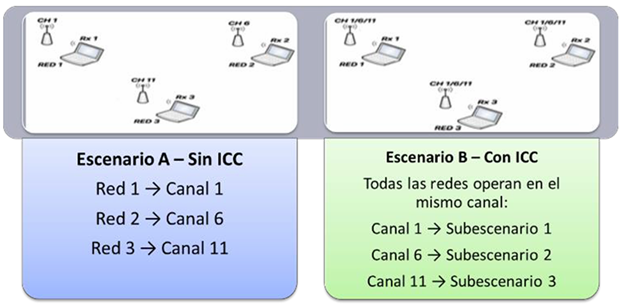Uplink performance evaluation of wireless networks based on IEEE 802.11g and IEEE 802.11n under co-channel interference
Main Article Content
Abstract
Due to their widespread use, wireless networks conforming to IEEE 802.11g/n standards can experience channel saturation, leading to interference that affects their performance. This study analyzes the performance of these networks under various interference scenarios, evaluating their behavior in terms of Quality of Service (QoS) metrics, including throughput, delay, jitter, and packet loss. Experiments were conducted in indoor environments using two standards, IEEE 802.11g/n, and different channel configurations. Initially, networks were evaluated in scenarios where all devices operated on the same channel (1, 6, or 11), creating co-channel interference. Subsequently, scenarios were analyzed where each access point operated on a different channel to minimize interference. The intrusive traffic injection technique was employed for data collection, enabling precise measurements of the analyzed metrics. The results indicate that network performance varies significantly depending on the standard used and the channel configuration. Overall, networks operating under the IEEE 802.11n standard exhibited better throughput performance but were more susceptible to interference compared to those operating under the IEEE 802.11g standard. Additionally, transmission efficiency decreased significantly in the presence of co-channel interference, with performance losses of up to 35% in some scenarios. These findings underscore the significance of effective channel planning in wireless networks, enabling optimal performance and mitigating the adverse effects of interference.
Downloads
Article Details

This work is licensed under a Creative Commons Attribution 4.0 International License.
Authors who publish in this journal agree to the following terms: Authors retain the copyright and guarantee the journal the right to be the first publication of the work, as well as, licensed under a Creative Commons Attribution License that allows others share the work with an acknowledgment of the authorship of the work and the initial publication in this journal. Authors may separately establish additional agreements for the non-exclusive distribution of the version of the work published in the journal (for example, placing it in an institutional repository or publishing it in a book), with acknowledgment of its initial publication in this journal. Authors are allowed and encouraged to disseminate their work electronically (for example, in institutional repositories or on their own website) before and during the submission process, as it may lead to productive exchanges as well as further citation earliest and oldest of published works.
How to Cite
References
[1] IEEE Standard for Information Technology—Local and metropolitan area networks—Specific requirements—Part 11: Wireless LAN Medium Access Control (MAC) and Physical Layer (PHY) Specifications, Amendment 5: Enhancements for Higher Throughput.
[2] D. Crespo Sen, “Mecanismos de Asignación de Canales en Redes IEEE 802.11,” Universidad de Alcalá, 2019. [Online]. Available: https://ebuah.uah.es/dspace/bitstream/handle/10017/ 38651/TFG_Crespo_Sen_2019.pdf
[3] C. Muñoz Morales, "Análisis de Desempeño de un Sistema MIMO-OFDM con Predicción de Canal," Doctoral Dissertation, Universidad Nacional de Colombia, Bogotá DC., 2013.
[4] S. H. Masood, “Comparación del rendimiento de IEEE 802.11g e IEEE 802.11n en presencia de interferencia de redes 802.15.4,” arXiv preprint arXiv:1308.0678, 2013. [Online]. Available: https://arxiv.org/abs/1308.0678.
[5] R. A. Lara Cueva, C. B. Fernández Jimenez, and C. A. Morales Maldonado, "Análisis del desempeño en un enlace descendente de redes basadas en los estándares IEEE 802.11b, IEEE 802.11n y WDS," Reci, vol. 5, no. 10, 2016.
[6] S. H. Masood, “Comparación del rendimiento de IEEE 802.11g e IEEE 802.11n en presencia de interferencia de redes 802.15.4,” arXiv preprint arXiv:1308.0678, 2013. [Online]. Available: https://arxiv.org/abs/1308.0678
[7] S. M. Kala, M. P. K. Reddy, R. Musham, B. R. Tamma, “Radio Co-location Aware Channel Assignments for Interference Mitigation in Wireless Mesh Networks,” arXiv preprint arXiv:1503.04533, 2015. [Online]. Available: https://arxiv.org/abs/1503.04533
[8] J. L. Muñoz, “Análisis del rendimiento en redes WLAN: caso de estudio,” Universidad Católica de Colombia, 2014. [Online]. Available: https://repository.ucatolica.edu.co/bitstream/10983/ 1300/3/Articulo_trabajo%20de%20grado.pdf
[9] L. F. Pedraza, “Consideraciones para la implementación de voz sobre WLAN,” Universidad Industrial de Santander, 2006. [Online]. Available: https://noesis.uis.edu.co/bitstreams/33e56af9-f5b4- 44d7-8572-ffc4339b29b8/download

